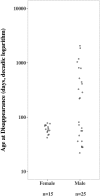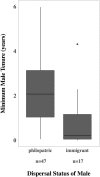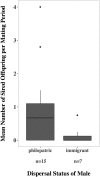The evolution of a rare mammalian trait - benefits and costs of male philopatry in proboscis bats
- PMID: 29142308
- PMCID: PMC5688083
- DOI: 10.1038/s41598-017-15990-6
The evolution of a rare mammalian trait - benefits and costs of male philopatry in proboscis bats
Abstract
While inbreeding avoidance is widely accepted as the major driver of female natal dispersal, the evolution of male philopatry is still poorly understood and discussed to be driven by male mating strategy, mate competition among male kin and kin cooperation. During a twelve-year study, we gathered detailed genetic and observational data of individually marked proboscis bats to assess the degree of male philopatry as well as its costs and benefits to improve the understanding of its evolution. Our results reveal several patrilines with simultaneous presence of closely related males and a small proportion of unrelated immigrant males in their colonies. Philopatric males benefit from avoiding the costs of immigration into foreign colonies through significantly longer tenure, better integration (i.e. frequent nocturnal presence in the colonies) and consequently significantly higher reproductive success compared to immigrant males. Finally, we illustrate that despite a high proportion of philopatric males in the groups, the number of closely related competing males is low. Thus, the hypothesised costs of mate competition among male kin seem to be low in promiscuous mammalian societies with unrelated females and a small degree of male immigration and are readily outweighed by the benefits of staying in the natal group.
Conflict of interest statement
The authors declare that they have no competing interests.
Figures






Similar articles
-
Female-biased dispersal in a bat with a female-defence mating strategy.Mol Ecol. 2013 Mar;22(6):1733-45. doi: 10.1111/mec.12202. Epub 2013 Feb 4. Mol Ecol. 2013. PMID: 23379356
-
Female-biased dispersal and patrilocal kin groups in a mammal with resource-defence polygyny.Proc Biol Sci. 2007 Dec 7;274(1628):3019-25. doi: 10.1098/rspb.2007.1008. Proc Biol Sci. 2007. PMID: 17913693 Free PMC article.
-
Female mate-choice drives the evolution of male-biased dispersal in a social mammal.Nature. 2007 Aug 16;448(7155):798-801. doi: 10.1038/nature06040. Nature. 2007. PMID: 17700698
-
Sex-biased dispersal: a review of the theory.Biol Rev Camb Philos Soc. 2019 Apr;94(2):721-736. doi: 10.1111/brv.12475. Epub 2018 Oct 24. Biol Rev Camb Philos Soc. 2019. PMID: 30353655 Free PMC article. Review.
-
Mate choice: female relatives share sexual partners in bats.Curr Biol. 2005 Nov 22;15(22):R927-9. doi: 10.1016/j.cub.2005.10.059. Curr Biol. 2005. PMID: 16303552 Review.
References
-
- Clobert, J., Danchin, E., Dhondt, A. A. & Nichols, J. D. Dispersal (Oxford University Press Oxford, 2001).
-
- Van Valen, L. Group selection and the evolution of dispersal. Evolution 591–598, 10.2307/2406942 (1971). - PubMed
-
- Greenwood PJ. Mating systems, philopatry and dispersal in birds and mammals. Animal Behaviour. 1980;28:1140–1162. doi: 10.1016/S0003-3472(80)80103-5. - DOI
-
- Dobson FS. Competition for mates and predominant juvenile male dispersal in mammals. Animal Behaviour. 1982;30:1183–1192. doi: 10.1016/S0003-3472(82)80209-1. - DOI
MeSH terms
LinkOut - more resources
Full Text Sources
Other Literature Sources

